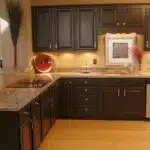Painting an interior door may seem like a simple task, but it requires careful planning and execution to achieve a flawless finish. As a professional painter or painting contractor, ensuring that the door is free from bumps, scratches, and other imperfections is crucial to achieving customer satisfaction. Not only does a well-painted door enhance the overall aesthetic appeal of the room, but it also adds value to the property.
To paint an interior door efficiently, one must understand the materials and tools required for the job. Factors such as surface preparation, choice of paint type and color, as well as techniques used in applying coats of paint are essential elements in producing a high-quality result. In this article, we will detail all the necessary steps a painter needs to follow when painting an interior door. By following these guidelines, you can ensure that your clients’ doors are painted with precision and care, resulting in a transformation that they will appreciate for years to come.
Choosing The Right Paint Color
A crucial aspect of painting an interior door is choosing the right paint color. Color psychology plays a significant role in determining the overall mood and ambiance of a room. Hence, selecting a color that complements the existing decor is necessary for creating a cohesive look. A professional painter or contractor would advise homeowners to consider the undertones of their furniture, flooring, and walls before picking out a color for their door.
In addition to coordinating with room decor, it’s essential to choose the right finish and sheen level for the paint. Different finishes such as matte, eggshell, satin, semi-gloss, and high-gloss have varying levels of reflectivity and durability. For instance, matte finishes are ideal for hiding surface imperfections but may not be suitable for high traffic areas as they tend to scuff easily. On the other hand, high-gloss finishes offer excellent durability but are prone to showing brushstrokes.
When deciding on the color and finish for an interior door, it’s crucial to consider all these factors. A professional painter would recommend testing out samples in different lighting conditions before making a final decision. In the next section, we’ll discuss how to select the right paint type based on the type of material your door is made from.
Selecting The Right Paint Type
Choosing the right paint color is crucial when painting an interior door, but it’s equally important to consider the paint sheen options. The most common paint sheens are flat, eggshell, satin, semi-gloss, and high-gloss. Each of these has its own unique characteristics that can add to or detract from the finished look of your door. Flat paint gives a matte finish and is best for hiding imperfections on the surface. Eggshell and satin are more popular because they give a slightly glossy finish while still being easy to clean. Semi-gloss and high-gloss paints have higher durability but show imperfections more clearly.
The importance of ventilation during painting cannot be overstated. Proper ventilation helps prevent paint fumes from building up and causing health problems for those in the area. Before you start painting your interior door, make sure there is plenty of fresh air circulating through the room. Open windows and doors if possible, or use fans to help move air around. If you’re working in a poorly ventilated area, consider using a respirator mask to protect your lungs from harmful fumes.
Now that you’ve chosen the right color and sheen for your interior door and have made sure there’s adequate ventilation in the room, it’s time to gather the necessary tools and materials for painting. You’ll need brushes or rollers (depending on personal preference), painter’s tape to protect areas you don’t want painted, sandpaper to smooth out any rough spots on the surface, primer if needed, and of course your chosen paint color in the appropriate sheen. Once all of these items are gathered together in one place, you’ll be ready to start prepping your door for painting!
Gathering The Necessary Tools And Materials
Did you know that a properly painted door can add significant value to your home? According to a recent survey, homeowners who repaint their doors can see up to a 5% increase in their property’s value. Painting an interior door can seem like a daunting task, but with the proper tools and materials, anyone can do it.
Before beginning your painting project, gather the necessary tools and materials. Here are some items you will need:
- Paintbrushes in various sizes
- Painter’s tape
- Sandpaper (120 grit)
- Drop cloths or plastic sheeting
- Paint of your choice
Tips for minimizing mess include using drop cloths or plastic sheeting to protect floors and furniture from paint drips. Additionally, painter’s tape can be used to mask off areas such as doorknobs and hinges. Proper ventilation is crucial when painting indoors; open windows and doors or use fans to ensure fresh air circulation.
Properly ventilating the work area is essential for a successful paint job. Open all windows and doors when possible, or use fans to circulate fresh air throughout the space. When working with oil-based paints or primers, consider wearing a respirator for added protection. In the next section, we will discuss how to properly prepare the door surface before applying any paint.
Preparing The Door Surface
Before painting an interior door, it is crucial to prepare the surface to ensure a smooth and even finish. One of the first steps in preparing the door surface is sanding. Sanding helps remove any rough spots, bumps, or imperfections on the door’s surface that may prevent the paint from adhering properly. It also smooths out any scratches or dents on the door.
Tips for sanding include using fine-grit sandpaper and sanding in the direction of the wood grain. Avoid applying too much pressure while sanding as this can cause damage to the wood or create uneven surfaces. Once done, wipe down the surface with a clean cloth to remove any dust or debris.
Another important step in preparing an interior door for painting is taping off areas that should not be painted. This includes doorknobs, locks, hinges, and other hardware. When preparing with tape, there are some Dos and Don’ts to consider. Do use a high-quality painter’s tape that will not leave residue behind after removing it. Don’t use regular masking tape as it can peel off any existing paint or finish on the door. Additionally, take your time when taping off small areas to ensure accuracy and precision.
As you prepare your door for painting by sanding and taping off necessary areas, keep in mind that removing the door hardware is also essential for achieving a flawless finish. In our next section, we’ll discuss how to safely remove doorknobs and hinges without damaging them or the surrounding woodwork.
Removing The Door Hardware
After preparing the door surface, it is time to remove the hardware. Did you know that many painting projects are delayed or damaged because of hardware removal? According to a recent survey conducted by Professional Painters Association, 45% of painters reported that hardware removal caused damage to the door, and over 25% said they experienced delays due to difficulties in removing hardware.
To avoid such issues, here are some tips for removing hardware without damaging the door. Firstly, use a screwdriver or drill with a suitable head to remove screws from hinges and doorknobs. Secondly, if any screws are hard to remove, apply some penetrating oil or lubricant and wait for a few minutes before trying again. Lastly, avoid using excessive force or prying tools as these can cause damage.
It is also important to take precautions while removing hardware to avoid injury. Be sure to wear gloves and safety glasses when handling tools and screws. Place all removed hardware in a container so you don’t lose them, and keep them organized according to their location on the door so you can easily reattach them later. With these tips in mind, you can safely remove your door’s hardware in preparation for sanding the door surface.
Sanding The Door
- Preparing to paint an interior door requires gathering the necessary supplies such as sandpaper, a sanding block, and a vacuum cleaner.
- Sanding should be done in an up and down motion with the grain of the wood.
- A finer grit sandpaper should be used to sand any areas with raised grain or rough edges.
- Sanding should be done until all imperfections are removed and the door is smooth to the touch.
- Any dust should be removed with a vacuum before priming and painting the door.
- Finishing touches may include applying a sealer before painting and applying a second coat of paint for a smooth and even finish.
Gather Supplies
Preparing to paint an interior door can be both exciting and daunting. Whether you are a seasoned painter or a novice, it is essential to gather all necessary supplies before sanding the door. Proper preparation will help ensure a smooth and successful painting project. Here are some tips for organization and pre-painting door maintenance.
Firstly, make sure to have all the necessary tools at hand. This includes sandpaper, a putty knife, wood filler, masking tape, drop cloths, and cleaning supplies such as soap and water or vinegar. Organize these items in a clear space near the door you plan to paint. It’s important to have everything within reach so that you don’t waste time searching for them while working on the project.
Secondly, before starting sanding, inspect the door for any damage or imperfections. Repair any cracks or holes using wood filler and let it dry according to the manufacturer’s instructions. Once dry, use a putty knife to smooth out any excess filler before sanding it down with fine-grit sandpaper. This will ensure that your final paint job looks clean and polished.
Lastly, ensure that the surface of the door is clean and free from dirt and dust before beginning any sanding work. Use soap and water or vinegar solution to clean the surface thoroughly, then allow it to air dry completely before proceeding with sanding. Keeping up with these pre-painting maintenance tasks ensures that your painted interior doors will look beautiful and last for years to come!
Sanding Techniques
When preparing to paint an interior door, proper sanding techniques are crucial in achieving a smooth and polished finish. The first step is to choose the correct sandpaper grits for the job. For removing rough patches and old paint, start with a coarse grit such as 80 or 100. As you progress towards a smoother surface, switch to finer grits such as 120 or 150. Remember to always work your way up from the coarsest to the finest grit.
Another important aspect of sanding is using proper sanding block techniques. Sanding blocks provide even pressure across the surface being sanded, which helps prevent uneven surfaces and gouges. For flat surfaces, use a flat sanding block and move back and forth in straight lines along the grain of the wood. For curved or contoured surfaces, use a flexible sanding block that conforms to the shape of the wood.
It’s important to pay attention to detail when sanding an interior door. Take your time and ensure that all areas, including corners and edges, are sanded evenly with no rough spots left behind. Remember that proper preparation ensures a successful painting project, so don’t rush through this critical step!
Finishing Touches
After sanding the interior door and achieving a smooth surface, the next step is to add decorative accents. Adding a pop of color or design can enhance the overall appearance of the door and complement the room’s decor. A professional painter or painting contractor may suggest different techniques such as stenciling, adding trim, or using textured paint to create unique designs. However, it’s important to keep in mind that less is often more when it comes to decorative accents. Choose a design that complements the style of the room and doesn’t overwhelm the space.
Another important aspect of finishing touches for an interior door is choosing the right door handle. The right handle can make a big difference in both aesthetics and functionality. A professional painter or painting contractor may recommend choosing a handle that matches other hardware in the room, such as light fixtures or cabinet knobs. Additionally, consider factors such as ease of use, durability, and whether it provides adequate security for the room.
Overall, adding finishing touches is an essential step in completing an interior door painting project. Properly executed decorative accents and choosing the right door handle can provide added value to both the room and home overall. A professional painter or painting contractor will take great care in selecting these details to ensure they complement and enhance your space while providing functional benefits as well.
Filling In Cracks And Holes
When it comes to painting an interior door, filling in cracks and holes is an essential step that ensures a smooth and seamless finish. Using spackle is an effective way to fill in small cracks and gaps on the surface of the door. However, for larger cracks, it is necessary to use sandpaper to smooth out the area before applying spackle.
For holes, a putty knife can be used to apply spackle evenly. It is important to avoid overfilling the holes as this can create uneven surfaces that will be visible after paint application. After applying spackle or filling paste, allow sufficient drying time before proceeding with the next step.
When selecting a paint type for filling, choose one that has good adhesive properties such as latex or acrylic paints. These types of paints work well for filling because they adhere well to different surfaces and dry quickly. Remember to blend in any filled areas with the rest of the door by using a fine-grit sandpaper before proceeding with painting.
To ensure a flawless finish, it is crucial not to rush through this process. Take your time when filling in cracks and holes on your interior door and allow ample drying time between each step. Once you have completed this stage, you can move on to applying primer before finally painting your door with your chosen color.
Applying Primer
As we have seen in the previous section, filling in cracks and holes is an important step to ensure that the surface of the door is smooth before painting. Once this has been done, it’s time to move on to applying primer.
Before applying primer, it’s important to take some precautions to avoid mistakes. One common mistake is not allowing enough drying time between coats. Make sure you read the label on your primer and allow it to dry for the recommended amount of time before applying a second coat. Another mistake is using too much primer, which can lead to drips and uneven coverage. Apply a thin layer of primer with a quality brush or roller and let it dry completely before applying another coat.
One benefit of using a tinted primer is that it can help you achieve better color accuracy when painting over dark or bold colors. A tinted primer can also help reduce the number of coats needed for full coverage, saving you both time and money. Be sure to choose a tinted primer that matches the color of your final paint coat closely.
When it comes to choosing the right brush or roller for painting your interior door, there are several factors to consider. The size of the door will determine what size brush or roller you need, while the material of the brush bristles or roller cover will affect how smoothly the paint goes on. Keep these factors in mind as you choose your tools and always use high-quality brushes and rollers for best results.
Choosing The Right Brush Or Roller
When choosing the right paintbrush or roller for painting an interior door, it is important to consider the type of brush or roller available. Natural bristles, synthetic bristles, foam brushes and foam rollers are all common types of brushes that can be used. Additionally, the type of paint and its absorption rate also need to be taken into consideration when selecting a brush or roller to ensure that a smooth, even finish is achieved. This will help to ensure the best possible outcome for the painting job.
Types Of Brushes
When it comes to painting an interior door, choosing the right brush or roller is essential. There are two main types of brushes: bristle and foam. Bristle brushes are made of natural materials like animal hair and are best for oil-based paints, while foam brushes are synthetic and work well with water-based paints.
Another factor to consider when selecting a brush is whether it is angled or straight. Angled brushes are ideal for cutting in around edges and corners, while straight brushes are better suited for larger surface areas. Additionally, the best type of brush for different paint finishes varies. For matte finishes, use a short-bristled brush with dense bristles to evenly distribute the paint without leaving streaks. For glossy finishes, choose a longer-bristled brush with softer bristles to avoid leaving brush marks on the surface.
In conclusion, choosing the right type of brush can make all the difference in achieving a professional-looking finish on your interior door. Whether you opt for a bristle or foam brush and an angled or straight design will depend on the specific project at hand. By considering factors like paint finish and surface area, you can select the best tool for the job and achieve excellent results every time.
Paint Absorption Rate
When it comes to painting an interior door, selecting the right brush or roller is essential. However, it’s also important to consider the paint absorption rate of the tool. A brush or roller that absorbs too much paint will result in drips, runs, and a messy finish. To achieve a professional-looking coat with minimal paint wastage, you need to use a brush or roller with low paint absorption.
To minimize paint absorption rate, choose brushes with synthetic fibers or foam rollers made from materials like microfiber or sheepskin. These tools have a tighter weave or texture than natural fiber brushes and standard rollers, which means they absorb less paint while still providing an even coat. Additionally, using thinner coats of paint can help reduce absorption rates.
When choosing the right paint finish for interior doors, consider how it will affect the absorption rate of your brush or roller. Glossy finishes tend to have higher absorption rates because they dry slower and require more layers to achieve full coverage. Matte finishes are easier to work with as they dry faster and need fewer coats but may require specialized brushes for even application. By taking these factors into account when choosing your tools and finishes, you can ensure a successful painting project with minimal waste and excellent results every time.
Applying The First Coat Of Paint
Start by using painting techniques to apply the first coat of paint on the interior door. Use a brush or roller to apply a thin and even layer of paint. Avoid applying too much paint as it may lead to drips and uneven surfaces. It is important to ensure that each part of the door is evenly coated with paint.
After applying the first coat of paint, allow it to dry completely before moving on to the second coat. The drying time may vary depending on the type of paint used, humidity levels, and temperature. Generally, it takes about 4-6 hours for water-based paints to dry and 8-10 hours for oil-based paints.
During this drying time, avoid touching or leaning anything against the freshly painted surface as it can leave marks or smudges. Once the first coat has dried completely, inspect it carefully for any areas that need touch-ups or additional coats of paint. Only proceed with applying the second coat once you are satisfied with the quality of the first coat.
Applying The Second Coat Of Paint
As you apply the second coat of paint to your interior door, it’s important to maintain a steady pace and technique. Start by using a high-quality brush or roller to apply the paint in long, even strokes. Work from the top of the door down, and be sure to smooth out any drips or bubbles as you go.
One common mistake that amateur painters make is applying too much paint at once. This can lead to uneven coverage, drips, and longer drying times. Instead, focus on applying a thin layer of paint and allowing it to dry completely before adding another coat. This will ensure that each layer dries evenly and creates a smooth, professional finish.
Remember that drying time is crucial when painting an interior door. Be sure to follow the manufacturer’s instructions for drying times between coats, and allow each coat ample time to dry before moving on to the next one. Rushing this process can result in uneven coverage or damage to your hard work.
Next up: reinstalling the door hardware.
Reinstalling The Door Hardware
- Prior to beginning the reinstallation of the door hardware, it is important to ensure that the old hardware is removed in its entirety.
- Care should be taken to ensure that all previous mounting holes are filled with a spackling compound or wood filler before the new hardware is installed.
- The new hardware should be carefully secured with the appropriate screws, nails, and adhesive caulk to ensure a secure and long-lasting installation.
- The surface should be tested for level after the new hardware is installed to ensure proper alignment of the door.
Removing Old Hardware
When it comes to painting an interior door, one crucial step is to remove the old hardware. This is essential for achieving a smooth and professional-looking finish. Before replacing the hardware, take note of any damaged areas that may require repair.
To begin, gather the necessary tools such as screwdrivers and pliers. Carefully remove all screws and bolts from the door including hinges, knobs, locks or latches. Keep these pieces in a safe place to avoid misplacing them.
After removing the hardware, inspect the areas where they were attached for any damage or dents caused by wear and tear over time. If there are any imperfections, now is the time to repair them before painting. With these steps completed, you can move on to replacing the hardware with confidence knowing that your freshly painted door will look its best.
Securing New Hardware
After successfully removing the old hardware from the door, the next step is to secure new hardware in its place. It is important to pay close attention to the hardware placement and make sure that everything is aligned and properly installed. This will ensure that the door functions smoothly and looks professional.
When selecting a new door knob or lock, it is important to consider both functionality and aesthetics. Choose a style that complements the overall look of your interior design while also providing secure access to your space. There are a variety of finishes available, such as chrome or brass, which can enhance the beauty of your door and add value to your home.
Once you have chosen your new hardware, use a screwdriver to attach it to the door. Make sure that all screws are securely tightened so that they do not come loose over time. With the new hardware in place, take a step back and admire your newly painted and upgraded interior door!
Cleaning Up The Work Area
Once you have finished painting your interior door, it is crucial to clean up the work area. This not only ensures that the room looks neat and tidy, but it also prevents any paint spills or accidents from occurring. Organizing supplies is an essential part of cleaning up because it allows you to keep track of everything you used during the painting process.
Start by disposing of any used paint cans or brushes in a responsible manner. Make sure to wash out any brushes and rollers thoroughly with warm water and soap to remove all traces of paint. Once they are clean, hang them up or lay them flat on a piece of cardboard to dry.
Preventing paint spills is another important aspect of cleaning up after painting an interior door. A simple way to do this is by using a drop cloth or old sheet to cover the floor underneath where you will be working. This will protect your flooring from any accidental spills, drips, or splatters. By taking these steps, you can ensure that your work area stays organized and free from unwanted messes.
| Supplies | Organization |
|---|---|
| Paint cans | Store in designated area |
| Brushes/rollers | Clean with warm water and soap |
| Drop cloth/sheet | Fold neatly for storage |
Transition into the subsequent section: Once you have cleaned up your work area and organized all of your painting supplies, it’s time to inspect the finished product to ensure that everything looks perfect.
Inspecting The Finished Product
Like a chef who carefully inspects the presentation of their dish before sending it out to the dining room, a painter must also thoroughly inspect their finished product. Inspecting for imperfections is an important step in ensuring a high-quality paint job. Take the time to examine every inch of the door for any drips, brush marks, or uneven areas.
If any imperfections are found, they can be easily remedied by touching up the final product. Simply sand down any rough spots and apply a small amount of paint with a fine brush to blend in with the surrounding area. It’s better to take care of these minor touch-ups now instead of waiting until they become noticeable and require more extensive work.
Once you’re satisfied that your painted door is free from blemishes or defects, it’s time to step back and admire your hard work. A freshly painted interior door can make a big difference in the overall look and feel of a room. With proper maintenance, your new paint job will continue to look great for years to come. In the next section, we’ll discuss some tips for maintaining your painted door so that it stays looking fresh and vibrant.
Tips For Maintaining A Painted Door
After inspecting the finished product, it is important to take steps to maintain its longevity. A painted interior door can experience wear and tear over time, especially in high traffic areas of the home. To ensure long term durability, consider the following tips:
- Clean regularly: Dust and dirt can accumulate on a painted surface and cause damage over time. Use a soft cloth or sponge to gently wipe down the door periodically.
- Avoid harsh chemicals: Abrasive cleaners or solvents can strip away paint and damage the underlying material. Stick with mild soaps and water for cleaning.
- Address damage promptly: If you notice scratches or chips in the paint, address them as soon as possible. This will prevent further damage from occurring.
- Use caution when hanging items: Nails or hooks can leave marks on a painted surface. Use adhesive hooks or other alternatives instead.
- Keep pets away: Pets can scratch at doors and cause damage to the paint.
In addition to these preventative measures, it’s also helpful to know touch up techniques for when damage does occur. For small chips or scratches, keep some extra paint on hand for touch ups. Use a small brush to carefully apply the paint and blend it in with the surrounding area. For larger areas of damage, consider repainting the entire door.
By taking these steps to maintain your painted interior door, you can enjoy its beauty for years to come without having to worry about constant maintenance or repair. Remember that prevention is key when it comes to keeping your home looking its best!
Conclusion
When it comes to painting an interior door, there are several important steps that must be taken to ensure a successful outcome. First and foremost, choosing the right paint color is crucial in achieving the desired look and feel for the room. Additionally, selecting the appropriate type of paint is essential in ensuring the longevity and durability of the painted surface.
Once you have selected your paint color and type, it is important to gather all necessary tools and materials before beginning the painting process. Proper preparation of the door surface is also critical in achieving a smooth and even finish. This includes removing door hardware, cleaning the surface, and filling any cracks or holes.
After painting, it is crucial to inspect the finished product for any imperfections and make necessary touch-ups. Lastly, maintaining a painted door requires regular cleaning and upkeep to ensure its longevity.
As a professional painting contractor, I cannot stress enough the importance of taking these necessary steps when painting an interior door. Whether you are a DIY enthusiast or seeking professional services, following these guidelines will ensure a beautiful and long-lasting result that will enhance any room in your home.
Image Credits
- “Double Mahogany Interior Doors” by DecoDesignCenter.com (featured)





























